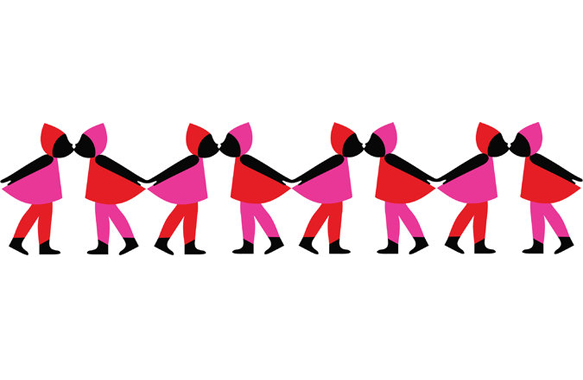Graphic; Olimpia Zagnoli
By Milena Tsvetkova and Michael Macy | Originally Published at Gray Matter. The New York times. March 14, 2014
ONE morning in December of 2012, at the drive-through window of a Tim Hortons coffee shop in Winnipeg, Manitoba, a customer paid for her order and then picked up the tab for the stranger in the car behind her in line. Then that customer paid the bill for the following customer in line — and so on, for the next 226 customers, in a three-hour sequence of spontaneous generosity.
It turns out that such “pay it forward” chains are not unheard-of at Tim Hortons (though they are usually much shorter), and news outlets have reported the emergence of many such chains in a variety of restaurant drive-throughs and tollbooths throughout North America. Last year, a Chick-fil-A in Houston experienced a 67-car chain. A few months later, a Heav’nly Donuts in Amesbury, Mass., had a run of 55 cars.
Why do these things happen? One possibility is that generosity among strangers can be socially contagious. According to this theory, if you receive or observe an act of help, you become more likely to help others, even if your own action won’t be directly reciprocated or rewarded. Rather than repay someone for helping, you “pay it forward” — a phrase popularized by Catherine Ryan Hyde’s 1999 novel of that title (later turned into a movie of the same name).
In recent years, social scientists have conducted experiments demonstrating that the effect of a single act of kindness can in fact ripple through a social network, setting off chains of generosity that reach far beyond the original act. But whether it is enough to merely witness a generous act, rather than actually benefit from one, has been an open question.
In an experiment the results of which were published last month in the journal PLoS One, we studied both possibilities. We found that receiving and observing generosity can both significantly increase your likelihood of being generous toward a stranger, but that if you observe a high enough level of generosity, your willingness to help suffers — you become a “bystander” who feels that help is no longer needed.
For our study, we recruited more than 600 participants from Amazon’s Mechanical Turk, an online marketplace where users advertise tasks to be completed in exchange for money. We enlisted them to participate in something we called the Invitation Game. They were informed that they could participate in the game and earn a base payment in cash and a cash bonus — but only if they received an email invitation.
To get the game started, we created a few invitations that we sent to randomly chosen participants. Those who received invitations were then informed that they had been assigned to play the game in a group of 150 people. Each “invitee” had the opportunity to create one additional invitation for a stranger in his group if he gave back the bonus and earned only the base payment. That invitation would be sent anonymously to the stranger.
Participants were randomly assigned to one of four situations: receiving help (they got an anonymous donated invitation created by another participant); observing help (they witnessed other participants anonymously donating invitations); receiving and observing help; and neither. (In the “neither” condition, participants received their invitation directly from the experimenters, which established a baseline condition against which to compare what happened when participants received or observed help, or both.) Then we observed how the participants chose to act in each situation.
What did we find out? The bad news was that the willingness to help suffered from what social psychologists call “the bystander effect”: When participants observed a low level of helping, it increased their own likelihood of helping; but when they observed a high level of helping, they did not themselves help — they appeared to feel that their own sacrifice was no longer needed. This finding was consistent with many previous studies of “social loafing,” “free riding” and “diffusion of responsibility.”
The good news was that receiving help reliably increased the likelihood of being generous toward a stranger, and that participants who benefited from generosity were also less susceptible to the bystander effect when they themselves observed high levels of helping in their group.
We conclude that observing an act of kindness is likely to play an important role in setting a cascade of generosity in motion, since many people can potentially observe a single act of helping. But we found that it was receiving help that sustained the cascade as it spread through the group.
Our research suggests that the next time you stop to help a stranger, you may be helping not only this one particular individual but potentially many others downstream. And who knows? In the end, maybe what goes around will come around.
Milena Tsvetkova is a doctoral candidate in sociology and Michael Macy is a professor of sociology, both at Cornell University.
A version of this op-ed appears in print on March 16, 2014, on page SR12 of the New York edition with the headline: The Science of ‘Paying It Forward’.












Leave A Comment